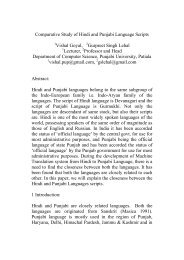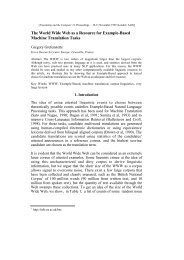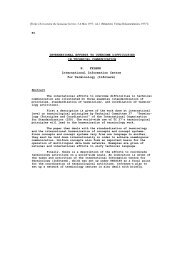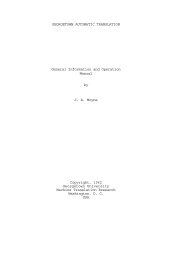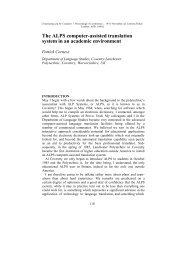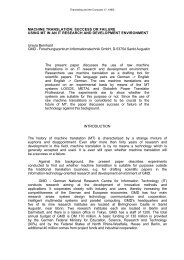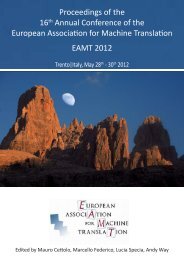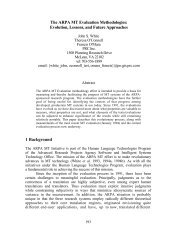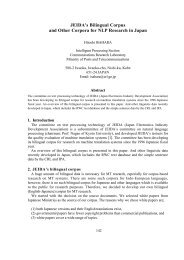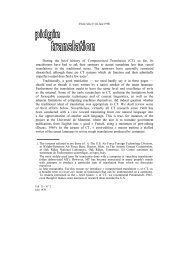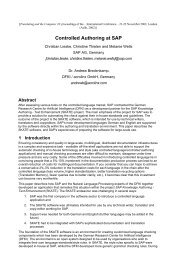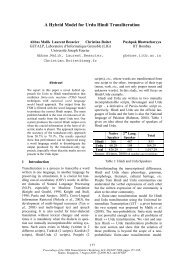The KIT lecture corpus for speech translation - Machine Translation ...
The KIT lecture corpus for speech translation - Machine Translation ...
The KIT lecture corpus for speech translation - Machine Translation ...
Create successful ePaper yourself
Turn your PDF publications into a flip-book with our unique Google optimized e-Paper software.
• <strong>The</strong> hash sign was omitted as a marker <strong>for</strong> numbers.<br />
• Numbers were written without a slash and separated<br />
in 10th groups (i.e. ”vierundfünfzig”, but ”ein hundert<br />
vierundfünfzig”)<br />
• Overlapping <strong>speech</strong>, background <strong>speech</strong>, and background<br />
noises are not annotated.<br />
<strong>The</strong> transcription is per<strong>for</strong>med in three stages. In the first<br />
stage a transcriber segments and transcribes the recording.<br />
In the second pass a different transcriber improves the transcripts<br />
of the first pass. In the third pass the output of the<br />
second pass is spell and sanity checked to account <strong>for</strong> new<br />
German spelling rules as well as typing errors.<br />
3.1.3. <strong>Translation</strong><br />
After transcription the German <strong>lecture</strong>s are translated into<br />
English and French. <strong>The</strong> <strong>translation</strong>s are per<strong>for</strong>med by student<br />
research assistants who study at the School of <strong>Translation</strong>,<br />
Interpreting, Linguistics and Cultural Studies of the<br />
University of Mainz in Germersheim, Germany. As translators<br />
in training they produce high-quality <strong>translation</strong>s <strong>for</strong><br />
the <strong>lecture</strong> transcriptions which present a challenging task<br />
containing on the one hand very specialized technical terms<br />
and on the other hand spontaneous and colloquial <strong>speech</strong>.<br />
We make sure that either the source or target language is the<br />
translator’s mother tongue. All translators work part-time<br />
and on an hourly basis as their study programme allows.<br />
4. Corpus Details and Transcriptions<br />
Our collection ef<strong>for</strong>ts already started in 2006, but have<br />
picked up pace over the last two years. While recording<br />
and annotation is still on-going we will give in the following<br />
paragraphs an overview of the current status of the size<br />
and properties of the <strong>corpus</strong> as of spring 2012.<br />
Table 1 gives an overview of the types and amounts of <strong>lecture</strong>s<br />
recorded. One can see that the bulk of the <strong>lecture</strong>s<br />
comes from computer science. This is due to the fact that<br />
in the beginning we exclusively collected computer science<br />
<strong>lecture</strong>s and only two years ago started to also collect <strong>lecture</strong>s<br />
from other departments. In addition to real university<br />
<strong>lecture</strong>s, we also occasionally collected <strong>speech</strong>es and addresses<br />
given by university representatives, e.g., the president<br />
of the university or the dean of a specific faculty, at<br />
festive or public events.<br />
As transcription is a time-intensive process, one can see that<br />
the majority of the recorded data is not transcribed yet. But<br />
at least within computer science, the amount of ca. 46h of<br />
completely transcribed and 29h of at least first pass transcribed<br />
<strong>lecture</strong>s is already significant and suited <strong>for</strong> traditional<br />
system development.<br />
<strong>The</strong> amount of translated material is naturally lacking behind<br />
the amount of transcribed material, as it has to wait <strong>for</strong><br />
the transcriptions first. <strong>The</strong> amount of material translated to<br />
French is particularly small, as we were only able to recruit<br />
one translator <strong>for</strong> French so far.<br />
Table 2 gives some more statistics on the <strong>lecture</strong>s. <strong>The</strong><br />
recorded <strong>lecture</strong>s contain a total of 44 speakers, the majority<br />
of them, 36, being male speakers. Most <strong>lecture</strong>s, 38,<br />
are from the computer science department, though these<br />
3412<br />
<strong>lecture</strong>s also contain <strong>lecture</strong>s from the so-called Center of<br />
Applied Law which teaches law with a focus on aspects related<br />
to in<strong>for</strong>mation technology, and is thus officially part<br />
of the computer science department. From non-computer<br />
science departments mostly only one <strong>lecture</strong> each has been<br />
recorded so far.<br />
In case we were able to record at least five <strong>lecture</strong>s of a<br />
class, we call this a series of <strong>lecture</strong>s, otherwise we talk<br />
of single <strong>lecture</strong>s. Most of the recordings of the <strong>lecture</strong>s<br />
are single <strong>lecture</strong>s instead of a series of <strong>lecture</strong>s from the<br />
same class. This is often due to the fact, that many <strong>lecture</strong>rs<br />
agreed to have one or two <strong>lecture</strong>s recorded, but thought the<br />
recording process to be too intrusive as to have the complete<br />
class recorded.<br />
Table 1: Duration of the recorded <strong>lecture</strong>s and word count<br />
statistics on the transcriptions and <strong>translation</strong>s<br />
Type of talk recorded (hh:mm:ss) # words<br />
Computer Science (CS)<br />
Total 185:21:09 -<br />
2nd pass transcribed 45:47:09 438,922<br />
1st pass transcribed 29:03:50 273,281<br />
not transcribed 110:30:10 -<br />
English <strong>translation</strong> 29:39:26 290,610<br />
French <strong>translation</strong> 2:00:36 20,878<br />
Non Computer Science<br />
(Non-CS)<br />
Total 7:52:16 88,214<br />
2nd pass transcribed 5:35:53 55,575<br />
1st pass transcribed 2:16:23 32,639<br />
English <strong>translation</strong> 3:47:25 43,301<br />
French <strong>translation</strong> 0:05:47 777<br />
Miscellaneous Talks<br />
(Misc)<br />
Total 4:13:13 -<br />
2nd pass transcribed 3:38:06 30,328<br />
not transcribed 0:35:07 -<br />
English <strong>translation</strong> 3:38:06 30,328<br />
5. Initial Experiments<br />
In order to give an impression of how difficult the collected<br />
<strong>lecture</strong>s are <strong>for</strong> the task of spoken language <strong>translation</strong>, we<br />
per<strong>for</strong>med some initial recognition and <strong>translation</strong> experiments<br />
on selected <strong>lecture</strong>s from our <strong>corpus</strong>. For these experiments<br />
we used a legacy <strong>speech</strong> recognition and a legacy<br />
<strong>translation</strong> system and concatenated them.<br />
5.1. Test Data Selection<br />
From the available <strong>lecture</strong>s we selected two of the miscellaneous<br />
talks and three of the computer science <strong>lecture</strong>s. One<br />
of the CS <strong>lecture</strong>s and one of the Misc talks were given<br />
by the same speaker. <strong>The</strong> <strong>lecture</strong>s were chosen, because<br />
transcriptions and <strong>translation</strong>s were available <strong>for</strong> them, and<br />
because they were not included in the training data of the<br />
machine <strong>translation</strong> system used, which has already been<br />
trained, at least in part, on the newly collected data.



